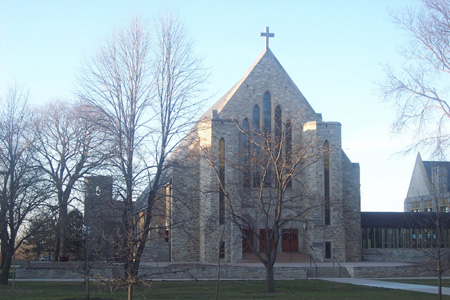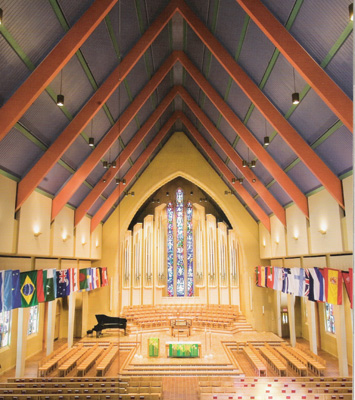 |
||||||||||
 |
||||||||||
|
1431: Boe Memorial Chapel, St Olaf College, Northfield,
Minnesota, USA Mystery Worshipper: Forradal. The church: Boe Memorial Chapel, St Olaf College, Northfield, Minnesota, USA. Denomination: Evangelical Lutheran Church in America (http://www.elca.org). The building: Contemporary Norman Gothic. The chapel was built and dedicated in 1954 and replaces an earlier chapel that was destroyed by fire. It was named in honor of Lars W. Boe, president of the college from 1918 to 1942. The outside is pleasant but somewhat unimaginative in design. The original interior was austere and cold, with very bad acoustics. It was said that, acoustically, the original design provided a good place to hold a barn dance! But renovations have been ongoing for some time, and the new acoustics are vastly improved, both for spoken word and music. The new space looks bright and open, with beautiful stained glass, although the many flags representing countries from which the student body has been drawn give the walls a distractingly cluttered look in the opinion of this Mystery Worshipper. A new 70 rank Holtkamp organ was installed in the chancel, with a 15 rank section of the organ located in the gallery. The altar and lectern are placed on a lower platform in front of the choir and organ, unfortunately allowing the organ pipes to overshadow both the altar and lectern and making it difficult to see the altar from the rear of the chapel. The church: The chapel is the "parish church away from home" for the St Olaf College student body. When school is in session, the eucharist is celebrated each Sunday, with meditation and prayer services offered during the week along with the occasional Lutheran matins, vespers or compline. When the college is in recess during Easter, six local Lutheran congregations come together at the chapel to celebrate the Great Easter Vigil in keeping with a long-standing tradition. The neighborhood: Northfield, about an hour's drive south of the Minneapolis/St Paul metropolitan area, was founded in 1855 by John W. North, whom President Abraham Lincoln later appointed official surveyor of the territory of Nevada (no easy job given the territory's abundance of overlapping mining claims). Northfield is a stately old city amid rolling farmland and tree-filled woods, with carefully restored Victorian and American prairie-style homes. A fall foliage visit to the area is a real treat! St Olaf College, named after the patron saint of Norway, was founded in 1874 and was closely associated with the Lutheran Church from the start. Most of St Olaf's original buildings were designed around a Norman Gothic theme. Newer additions are more modern in design, but as limestone is still favored as a construction material, the campus enjoys an overall unified appearance. The cast: The Revd Judy Reitz presided, assisted at the baptism by the Revd Mark Johnson. Also assisting was the Revd Joy Norquist, cantor, and seven other unnamed clergy from neighboring churches. The readers were Judy Swanson, Carrie Hoth, Thora Phelps and Arnold Witt. John Ferguson presided at the organ and directed the choir. There was also a large number of acolytes whose names were not listed. The date & time: Saturday, April 7, 2007, 7.30pm. What was the name of the service? The Great Vigil of Easter. How full was the building? There is seating for approximately 1200 worshippers. The chapel was about three-quarters full. Did anyone welcome you personally? Ushers handed out service folders and offered a simple, friendly good evening. This reserved greeting was appropriate with the darkened chapel, catching the last rays of sunlight, encouraging meditation, reflection and anticipation. Was your pew comfortable? A very standard type pew, but better than most. How would you describe the pre-service atmosphere? Quietly chatty, but chatty nonetheless, though the chapel lights were dimmed to encourage meditation on the mystery of Holy Week. What were the exact opening words of the service? "Let us pray," followed by an opening collect. What books did the congregation use during the service? The hymnal Evangelical Lutheran Worship and a well designed service bulletin with large size print. What musical instruments were played? Organ plus a very well rehearsed brass ensemble, hand bells and choir. The new Holtkamp organ has considerable power and was played expertly. The organist carefully selected his registrations throughout the service, using the different organ voices to add interest, sensitivity and richness to the liturgy and hymns without overpowering the worshippers with just "sound." The choir was composed of singers from the various churches participating in the service. Although they sang well, it seemed that they were not accustomed to singing together (slightly muddled chanting, etc.). Did anything distract you? I like to sit in the back when visiting. Directly in front of me were a young mother and father with two boys, aged about three and five I would guess. The boys fidgeted quietly but unobtrusively. It was a pleasant distraction to see the parents teaching their boys to worship by example. But sitting in the back can also lead to unpleasant distractions, such as late arriving worshippers (in this instance some were 20 minutes late). Was the worship stiff-upper-lip, happy clappy, or what? High Church Lutheran, with incense, bells and a cappella chanting, but without stiffness or rote formality. The solemn procession began in the darkened chapel with the lighted Pascal candle, thurifer, crucifer, acolytes, clergy and lectors. The Pascal acclamation "The light of Christ" was chanted, followed by the Easter proclamation (Exultet). During all of this, the acolytes lit stationary candles at various places in the chapel. During the sacrament of baptism, each worshipper lit his own candle. The candles were kept burning through the baptism, the a cappella chanting of the Easter litany, and the reading of the gospel. Festival chasubles were worn by many of the clergy. All of the ceremonies were carried out unobtrusively, reverently and with dignity. A rich and varied blend of musical styles was used, ranging from chant through "Jesus Christ is Risen Today" through a Tanzanian hymn "Christ has arisen, Alleluia" (Mfurahini, Haleluya) through Handel's Hallelujah Chorus.  Exactly how long was the sermon? There was no sermon! The focus was entirely on prayer, anticipation and celebration. I sympathize with the clergy in not making this vigil overly long. However, a brief five minute homily, with well chosen thoughts and words, would have added to the solemnity of the occasion. Which part of the service was like being in heaven? Two items: the hymn from Tanzania – both the tune and words still roll though my mind – and the a cappella chanting. The wonderful variety of musical styles served to heighten, not distract from the worship experience. And the way the candles were done wonderfully highlighted the Easter message: Christ, the Easter Light, has conquered a world darkened by sin. And which part was like being in... er... the other place? I have already pointed out that the altar/lectern dais is too low. Worship feels incomplete when one is unable to view and participate fully in all aspects of the liturgy, be it at the altar, lectern or nave. What happened when you hung around after the service looking lost? Though the hour was late, a large number of us stayed to hear the postlude, Widor's famous Toccata from his Fifth Symphony. What a wonderful piece of music to conclude this festival service! But as the last chord emerged from the mighty Holtkamp's pipes, everyone scurried home. How would you describe the after-service coffee? No coffee was offered. How would you feel about making this church your regular (where 10 = ecstatic, 0 = terminal)? 9 – The chapel's new acoustics have made this a wonderful worship space. However, although the public is welcome at all services, this is strictly speaking a student congregation, not a neighborhood family parish. Did the service make you feel glad to be a Christian? Yes. The liturgical journey of darkness to light provided an excellent daily metaphor for our Christian faith. What one thing will you remember about all this in seven days' time? The hymn from Tanzania! |
|
|
||||||||||||||||||||||||||||||||||||
| More Mystery Worshipper reports | |||||||||||||||||||||||||||||||||||||||
 |
|||||||||||||||||||||||||||||||||||||||






